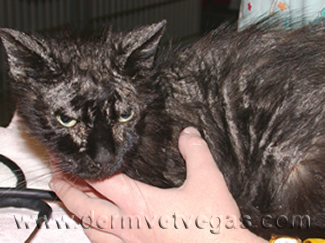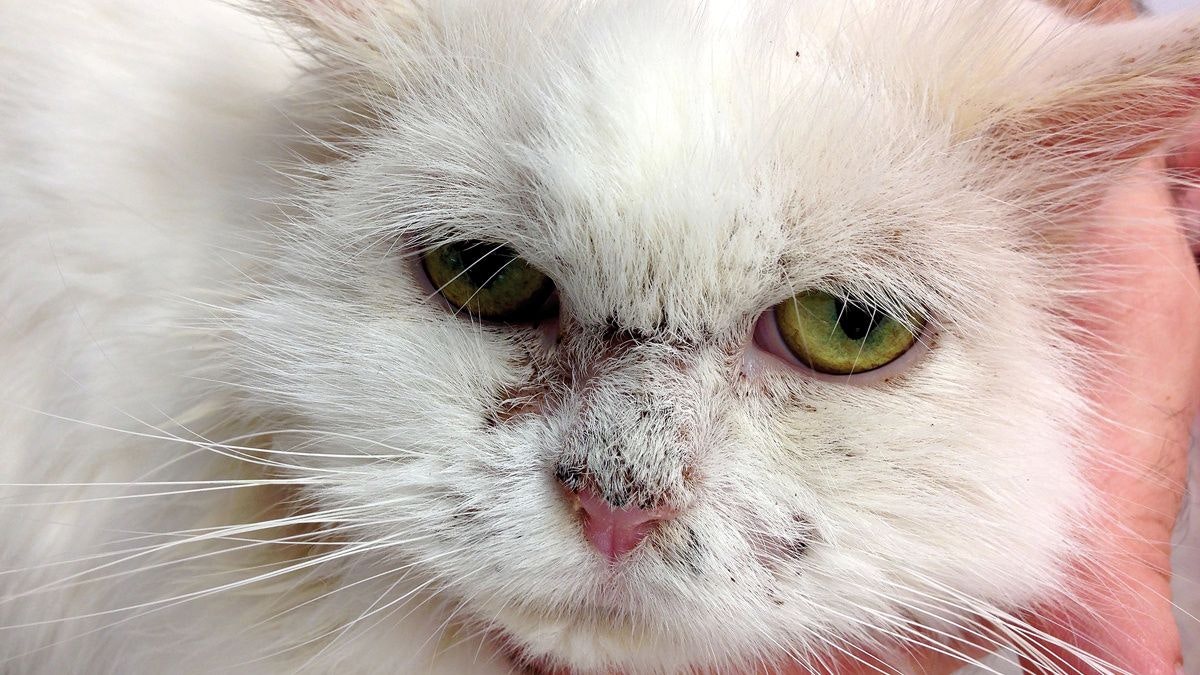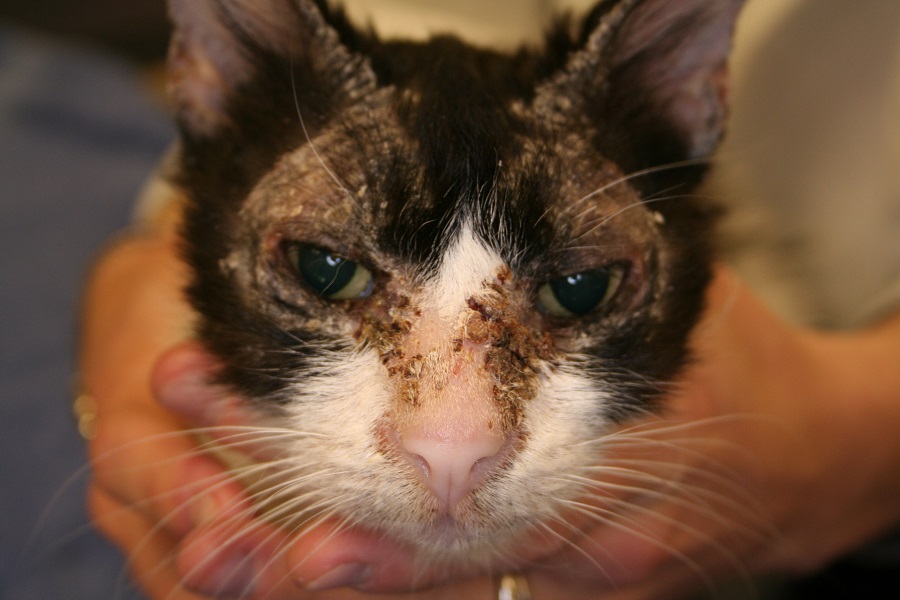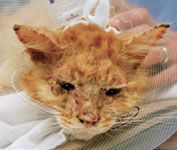pemphigus foliaceus disease in cats
Pemphigus foliaceus PF is the most common of these wherein autoantibodies are responsible for destroying the proteins that bind. Pemphigus foliaceus is an autoimmune disease whereby antibodies produced by an animals own immune system attack the bridges that hold skin cells together.
Pemphigus Foliaceus The Skin Vet
The disease usually appears to be idiopathic although it has been associated with drug administration and can develop subsequent to chronic usually allergic skin disease.

. It is also worth bearing in mind that biopsies from cats suffering from pemphigus foliaceus often also show large numbers of eosinophils. Cases have been seen in cats less than a year of age and in those more than 16 years. In cats pemphigus foliaceus is the most common autoimmune disease.
Crusting lesions are typical particularly of the nose face and pinnae Figure 1. This is the most common autoimmune skin disease of cats. FELINE PEMPHIGUS FOLIACEUS No age breed or sex predilection.
Pemphigus foliaceus PF is an immune-mediated disease that causes pustules and crusted lesions most commonly on the pinnae nasal planum periocular area chin and feet of affected cats. Does not solely involve. Use of prednisolone as monotherapy in the treatment of feline pemphigus foliaceus.
Pemphigus is a disease of dogs cats horses and goats and is a type of autoimmune skin disease. Because the majority of existing literature. Pemphigus foliaceus PF is also rare but is reportedly the most common autoimmune skin disease in dogs.
Most common type of pemphigus diagnosed in cats. Pemphigus Foliaceus PF - The term means leaf-like pemphigus. Definitive diagnosis is based on a combination of clinical history characteristic lesions and correlating histopathology.
An overproduction of autoantibodies attacks the epidermal bonding molecules causing them to separate resulting in the formation of superficial vesicles and bullae a blister that contains serous fluid which. Pemphigus Foliaceus PF The skin has scales crusts pustules shallow ulcers redness and itching Pads of the paws often have cracking and skin overgrowth Fluid-filled cysts or vesicles in the skin The areas most often affected include the head ears and footpads and eventually become. Rare auto-immune skin disease characterized by subcorneal vesicles or pustules.
Acantholytic cells caused by degradation of intercellular adhesions are often seen on cytology but are not pathognomonic for PF. The most serious of the pemphigus types More severe than pemphigus foliaceus and erythematosus Ulcers both shallow and deep blisters crusted skin Affects gums lips and skin. Pemphigus foliaceus PF is the most common autoimmune skin disease in dogs and cats.
It is a crusting dermatosis involving the ears head paws and ungual folds primarily. Pemphigus foliaceus is a severe skin disease that is characterized by pustules and. Pemphigus foliaceus is an autoimmune skin disease in cats.
These diseases result when the immune system functions abnormally targeting normal cells and structures of the body. You may also observe inflammation of their skin around the nail and itching. In-depth Information on Pemphigus Foliaceus in Cats.
Lesions may progress ventrally often surrounding the nipples. Immunosuppressive therapy including glucocorticoids cyclosporine and chlorambucil is commonly used to treat the disorder and typically remission is observed with treatment. In dogs Akitas Chow Chows Doberman Pinschers.
In other words it is. Although cytology is helpful in supporting a diagnosis biopsy of pustules or crusts for histopathology is required for a definitive diagnosis. A retrospective study of 37 cats.
Other types of Pemphigus are much less common. Pemphigus foliaceus PF is the most common autoimmune skin disease recognized in cats 1 2. Depigmentation is often noted with chronic disease.
Pemphigus foliaceus is a sterile pustular autoimmune disease where the IgG autoantibodies target the desmosomal glycoproteins responsible for cell-to-cell adhesion of keratinocytes in the epidermis. In cats lesions also develop at the toenail beds creating crusty sore feet. PF is the most common condition of the pemphigus complex 38 and is the most frequently occurring autoimmune skin condition in dogs cats and horses.
Although clinical symptoms can vary affected cats typically develop pustules and crusts on the face inner pinnae and paw pads along with paronychia. Pemphigus complex is a group of rare bullous autoimmune diseases in cats which are the result of an overactive immune response against the cats own tissues. Yellowish crusts are more frequently observed in cats when it comes to pemphigus foliaceus.
It is also the most common variant of pemphigus diseases12 which are characterized by autoantibodies that target keratinocyte desmosomal proteins leading to loss of cell-to-cell adhesion acantholysis. It is the most common autoimmune disease diagnosed in dogs and cats. Pemphigus foliaceus is an autoimmune disease.
Affected Animals Dogs and cats of any age or gender can be affected. Pemphigus foliaceus is a rare autoimmune skin disease that can affect many species. With PM the patient develops crusts scabs and ulcers around the eyes ears footpads groin and bridge of the nose.
In general it is an uncommon disease. PF is most often idiopathic but can also be paraneoplastic or iatrogenic. This disease occurs due to the immune system attacking its own skin cells.
Autoimmune dermatologic diseases are relatively rare in cats. Instead pemphigus is manifested as heavy serous yellow crusting. Drug-induced disease rarely involved.
Feline pemphigus foliaceus is an uncommon skin disorder in cats but still the most common autoimmune skin disorder seen in this species. Although these lesions look infected they typically are not. PM is rarely found in the mouth or at mucocutaneous junctions.
Pemphigus Foliaceus in Cats Overview of Pemphigus Foliaceus. Home Care for a Cat with. The autoimmune disorder feline pemphigus foliaceus PF typically causes dermatologic lesions on the face ears and paws.
However pemphigus foliaceus is the most common out of all the autoimmune skin diseases. It is defined as a pustular erosive and crusting dermatosis commonly involving the face ears and feet. Pustule formation on the concave pinna or focal serous crusting on the concave pinna should always ring a bell for possible pemphigus foliaceus in both cats and dogs.
May become generalized over the body Mouth ulcers are frequent may result in loss of appetite The underarm and groin. But the auto-immune condition I consult on most of all is Pemphigus Foliaceus PF in both dogs and cats. Thought to be an auto-immune skin disease resulting from auto-antibodies directed against desmoglein 1 intracellular substance causing acantholysis of keratinocytes.

Pemphigus Foliaceus A Case Study Veterinary Practice

Review Of Pemphigus Foliaceus In Dogs And Cats

Dermatology Clinic For Animals Pemphigus Foliaceus In Tacoma Wa Dermatology Clinic For Animals

Feline Pemphigus Foliaceus A Common Autoimmune Dermatosis Clinician S Brief
Pemphigus Wild Rose Cat Clinic Of Calgary

Pemphigus Foliaceus In Cats Symptoms And Treatment Medvet
Pemphigus Foliaceus In A Cat Vets On The Balkans An Online Journal For Veterinarians From The Balkans

How To Recognize Autoimmune Skin Disease Tips For Spotting Pemphigus Foliaceus

Feline Pemphigus Foliaceus A Common Autoimmune Dermatosis Clinician S Brief

Feline Pemphigus Foliaceus Diagnosis Treatment

Derm Spotlight Autoimmune Skin Disease In Cats Feline Pemphigus Animal Dermatology Referral Clinic Adrc

Beneficial Effect Of Oclacitinib In A Case Of Feline Pemphigus Foliaceus Carrasco 2021 Veterinary Dermatology Wiley Online Library
Pemphigus Foliaceus The Skin Vet
Pemphigus Foliaceus The Skin Vet

Feline Pemphigus Foliaceus Lesion Distribution Diagram And Individual Download Scientific Diagram

Canine And Feline Pemphigus Foliaceus Improving Your Chances Of A Successful Outcome

Dermatology Clinic For Animals Pemphigus Foliaceus In Tacoma Wa Dermatology Clinic For Animals
